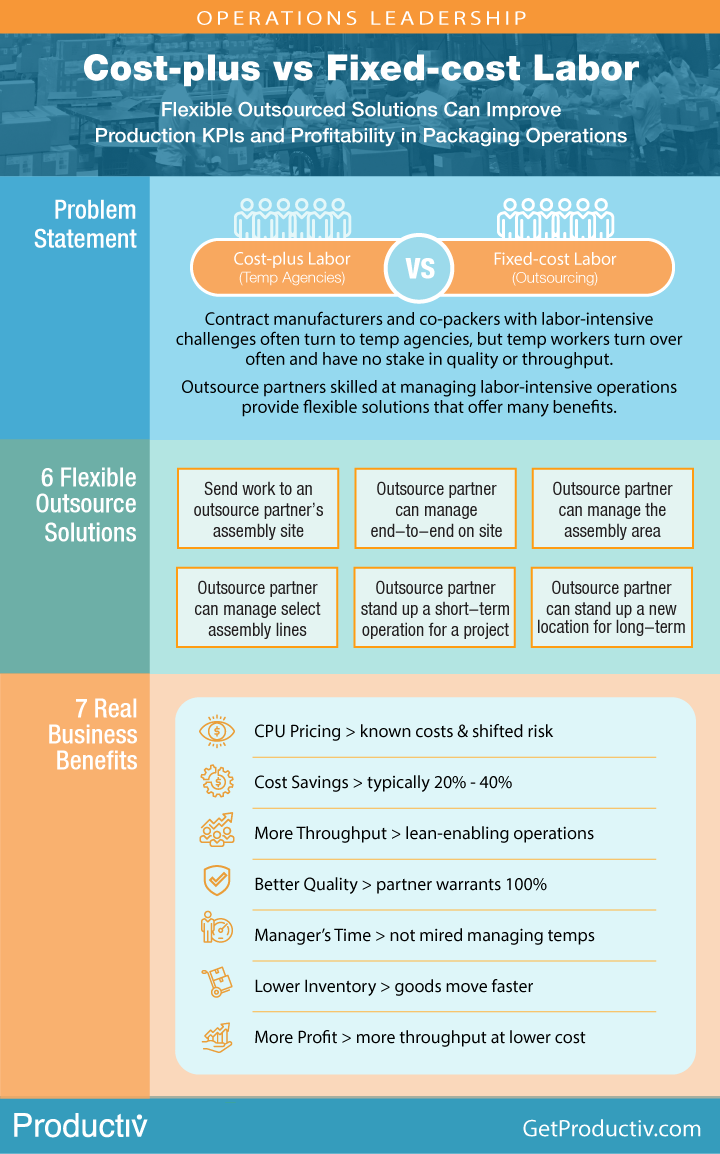2 min read
Staffing Agency Disadvantages: Cost-plus vs Fixed-Cost Labor
Innovative Labor Solutions for Contract Manufacturing, Packaging and Fulfillment Operations Due to surge demand, contract manufacturers and contract...
3 min read
Productiv : January 14, 2019

There are many ways to price handwork, and the method you choose typically will depend on the amount of information available. Often, the information you receive to price a job will range anywhere from descriptions on the back of an envelope to full assembly instructions accompanied by samples. If you have samples to work with, then it's definitely worthwhile to do a time study as a basis for your price quote. A time study uses a stopwatch to time how long it takes to build a single finished good. But, there are three main issues you’ll encounter when using only a time study to price hand work which could result in losing money on the job or losing out on the opportunity by mispricing it.
Issue 1: Non-Productive time If we do a time study and our results show that it takes 2 people each 1 minute to build 1 assembly, then we know the cost, right? We take an unskilled role at $15/hour burdened labor x 2 people = $30/hour. We can build 1 item per minute so we can build 60 items in an hour and therefore $30 hourly labor cost / 60 items per hour = $0.50 per item.If we price this way, we are likely underpricing the work by 100% because we aren’t taking into account non-productive time. Non-productive time includes breaks, schedule reliability, equipment reliability, waiting on materials, off-spec quality, overtime and rework.A manufacturing performance survey found that labor non-productive time percentage can range from 29% for the top 10% of companies all the way down to 76% for the bottom quartile. The average company has 56% of non-productive time. Therefore, the average performing company’s real cost would be $1.00 per item. Issue 2: Overhead While it may only take two people to perform the job, there are numerous support and overhead functions that go into the work. These include:
So how do we account for the overhead costs associated with the job? One rule of thumb is to look at your plant’s gross margin percentage. If your COGS operates at 75%, then adding 25% to your time study result will likely cover your overhead associated with the job. Of course, your gross margin percentage will change depending on the size, frequency and duration of the job as well as seasonality and variability in staffing requirements.Issue 3: Quality Anyone can perform a job in record time without quality constraints. For most jobs, though, the risk for not hitting quality targets is high and damages to the client relationship for delivering errors could be substantial. When pricing a handwork job, then, you’ll want to also account for the type of quality requirements. There are two main types of quality requirements:
In the first case, it may be necessary to use a weigh scale at the end of a process to confirm all components have been included, and add time for re-work of off-counts. In the second case, you’ll want to know the fastening tolerance as it relates to line speed. For example, a 1’’ tolerance may enable speeds of 1,000 units per hour whereas a 3/16’’ tolerance may slow the line speed to 150 units per hour.As discussed in “A Smarter Way to Manage Labor,” there are many steps you can take to drive efficiencies in handwork. These include using conveyor belts, adding team members in order to operate at ‘1 person 1 job’ smoothness, and using cultural incentives such as gainsharing and servant leadership to consistently achieve throughput and quality targets. By incorporating these efficiencies and incentives, you can offset the cost impact of (1) and (2) above while also improving quality through the use of single piece flow.To recap, if you are using time studies to price handwork, then you will want to take into account non-productive time, overhead and quality requirements to be more accurate. An even better way to price a job is to look at how many pallets of finished goods are being produced on average each day or week. Knowing specifically your production rate and costs will cancel out the effects of non-productive labor time and significantly dilute the overhead variable. Keep in mind, if you are doing the handwork on tables instead of using conveyor belts, then you can also gain efficiencies by using conveyors and optimizing the process. Doing this adds incremental profit to you, and time and cost savings for your client.
Get ideas on how to delight your customers with delivery on their timeline.

2 min read
Innovative Labor Solutions for Contract Manufacturing, Packaging and Fulfillment Operations Due to surge demand, contract manufacturers and contract...

1 min read
What if you could play Eruption on the guitar like Eddie Van Halen simply by practicing for 10,000 hours? Or consistently play par golf with the same...

5 min read
In recent months, the global trade landscape has been in flux, and businesses that rely on kitting and assembly operations in Mexico are now facing...